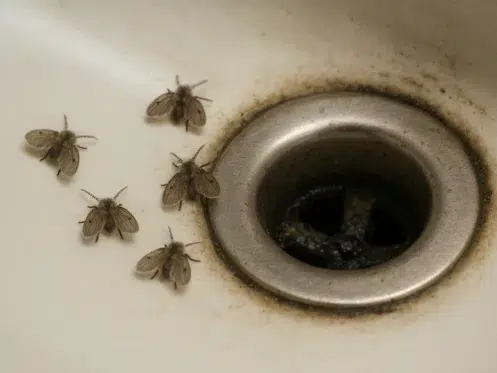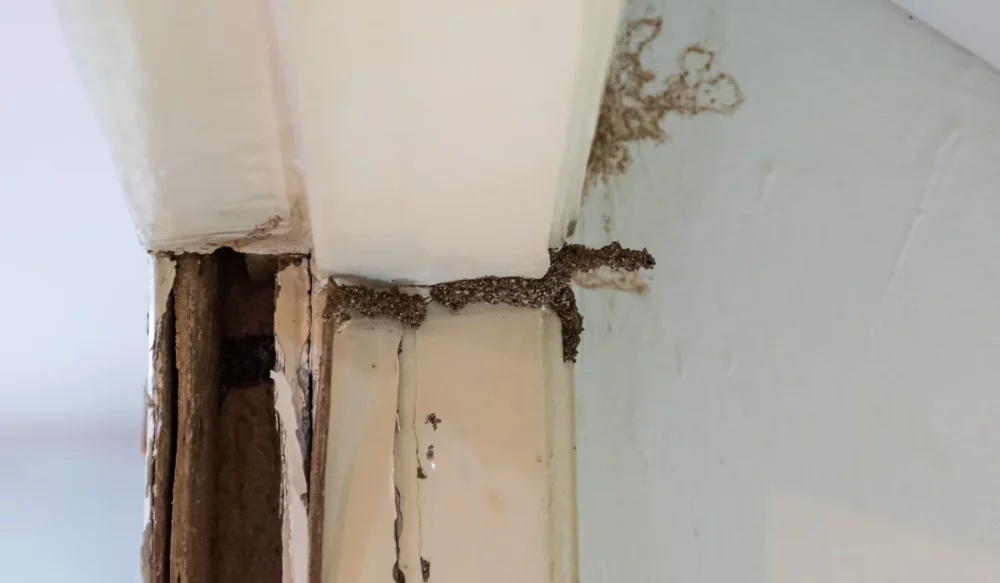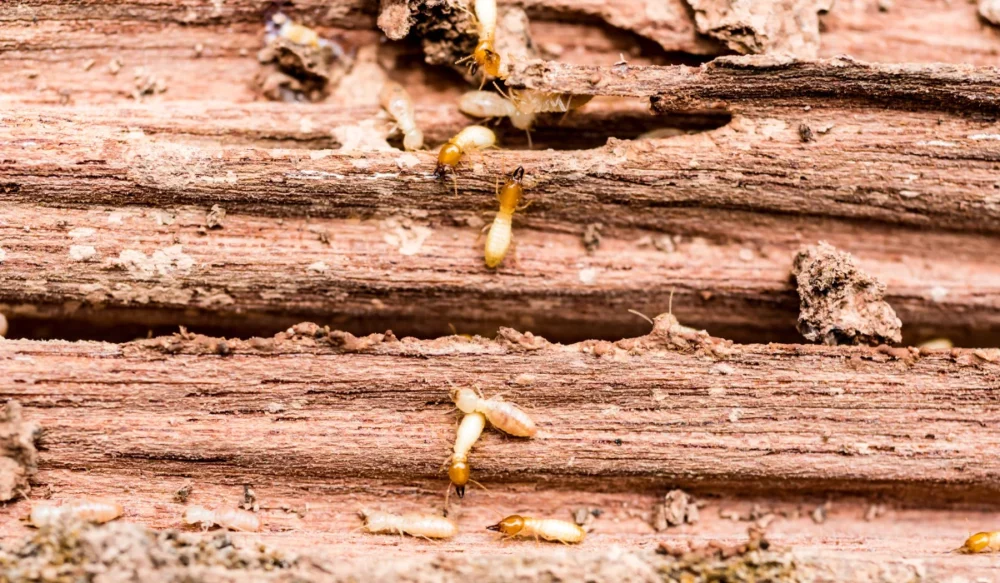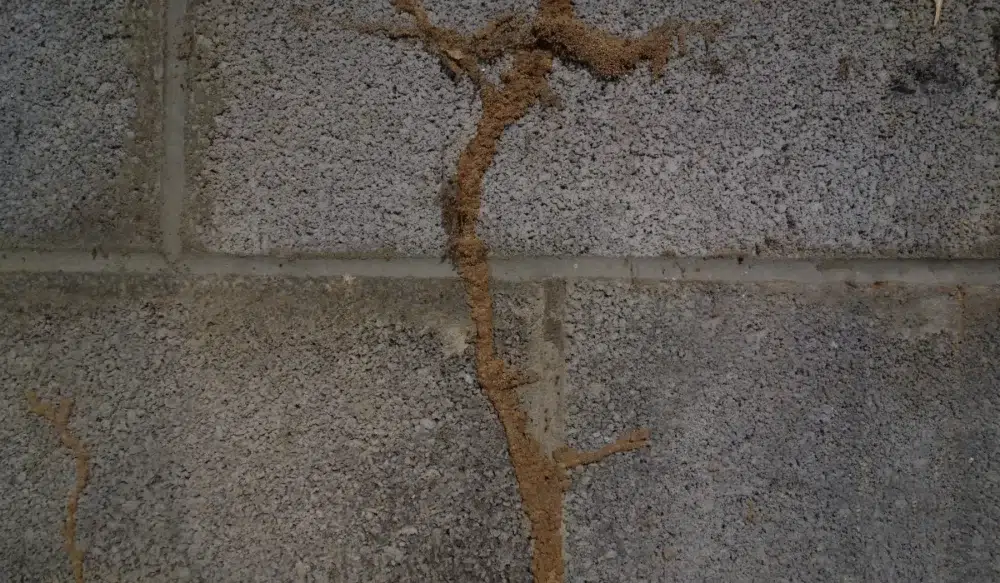If you’ve noticed tiny fuzzy bugs hanging around your sink or shower, you might be dealing with a drain fly infestation. These pests, also known as moth flies or sewer gnats, love moist places and organic buildup.
In Arizona, where heat and indoor humidity collide, especially in bathrooms and kitchens, drain flies can find the perfect place to settle in.
They aren’t dangerous, but that doesn’t mean they’re welcome. If they’ve moved into your drains, it’s time to act. In this guide, you’ll learn what causes a drain fly infestation in Arizona, how to identify it, and what works to get rid of it.
Key Takeaways
- Drain flies live in and around drains with organic buildup like soap scum, food residue, or gunk
- You’re more likely to see them in areas with standing water, such as sink drains, floor drains, or bathtubs
- Boiling water, baking soda, and enzyme cleaners can help break up their breeding ground
- If DIY treatments don’t work, professional pest control offers safe and long-term solutions
What Are Drain Flies?
Drain flies are small, fuzzy insects that look like tiny gray moths. They have short antennae, rounded wings, and a weak flying pattern. You’ll usually spot them near sink drains, showers, or even septic tanks, where there’s a consistent source of moisture and organic material.
Unlike house flies or fruit flies, drain flies ignore open food and head straight for the grime inside your pipes. That sludge becomes their primary food source, and also where they lay eggs.
What Causes Drain Flies in Arizona Homes?
In homes across Phoenix, Chandler, Scottsdale, and Tucson, drain fly problems tend to flare up during warmer months. The heat speeds up the fly life cycle, and indoor plumbing can create hidden breeding sites.
Common causes include slow-draining sinks with gunk or hair buildup, floor drains that sit unused for long periods, leaky pipes or condensation, and stagnant water collecting under appliances. Even spotless homes can experience a drain fly infestation if there’s an unnoticed buildup inside the plumbing.
Signs You Have a Drain Fly Problem
If you’ve got a fly problem inside your bathroom or kitchen, you’ll probably notice these signs:
- Small fuzzy adult drain flies resting on tile walls or near sinks
- Flies appear after running water or using the garbage disposal
- A musty smell near the drain pipes
- Visible drain fly larvae, tiny, worm-like creatures inside the drain slime
If you suspect the drain is the source, try this test: place clear tape (sticky side down) over the drain at night. If you find flies stuck to it the next morning, you’ve confirmed their presence.
Understanding the Drain Fly Life Cycle
Getting rid of drain flies means understanding how quickly they reproduce. Drain flies complete their life cycle in under two weeks. Skipping treatment for even a few days gives them time to multiply.
Female drain flies lay eggs inside the gunk or sludge in your pipes. Larvae hatch and eat the gunk inside the drain. Pupae develop into adults within days. Adults live about 14 days, repeating the cycle. Their breeding ground is typically the hidden slime in your plumbing, not the visible surfaces, so you won’t solve the issue by just cleaning the sink bowl.
How to Get Rid of Drain Flies Naturally
For light infestations, try these DIY methods to clean out their breeding sites:
Boiling water
Pour a pot of hot water down each affected drain. Do this twice a day for a week to dislodge grime and kill larvae.
Baking soda and vinegar
Pour ½ cup of baking soda, followed by 1 cup of vinegar, into the drain. Let it sit for 15 minutes, then flush with hot water. This natural mix helps break up organic residue.
Enzyme cleaners
Use a natural, enzyme-based drain cleaner designed to dissolve organic buildup. These are especially helpful for older pipes with recurring issues.
Fly traps
Place sticky traps near infested drains to catch adult flies while you treat the source. These won’t stop new flies from emerging, but they help reduce visible numbers.
Skip bleach or harsh chemicals
Avoid using bleach or heavy-duty drain cleaners. They often don’t reach deep enough into the pipes and can create toxic fumes, especially in small bathrooms.
Why DIY Methods Sometimes Fail
You might kill a few adult drain flies, but if you don’t eliminate their breeding sites, the eggs hatch, and the cycle continues. DIY methods often fall short when the sludge is deeper than boiling water can reach, there’s significant buildup inside pipes or behind walls, or you’re treating the wrong drain entirely.
If DIY methods don’t solve the problem or the infestation keeps coming back, it’s time to call professional exterminators. At Green Home Pest Control, we specialize in identifying and treating drain fly infestations across Arizona. Our methods are safe, effective, and designed to eliminate both larvae and adults for long-term results.
Prevention Tips for Arizona Homes
Once the flies are gone, a few minor changes can prevent them from coming back. Run water regularly through guest bathroom sinks or floor drains. Clean drain covers and necks weekly. Avoid pouring grease or food scraps down sink drains. Use natural drain cleaners monthly to prevent organic material buildup.
In Phoenix and Chandler homes, especially during summer or monsoon season, staying proactive helps you avoid another drain fly infestation.
Final Thoughts
A drain fly infestation in Arizona bathrooms or kitchens can be a nuisance, but you can get rid of them with the proper steps.
Begin with natural methods, such as baking soda, enzyme products, and boiling water. If those don’t solve the problem, professional pest control is the next step. At Green Home Pest Control, we help homeowners in Phoenix, Chandler, Tucson, and Scottsdale eliminate flies at the source and keep drains clean and pest-free for good.
Contact us today for help clearing your drains and your home of these stubborn pests.
FAQs
How do I know if I have drain flies or fruit flies?
Fruit flies gather near fruit and sugary substances. Drain flies prefer damp drains with organic buildup. If you see small, fuzzy-winged flies near sinks or showers, they’re likely drain flies.
Are drain flies a health risk?
Drain flies don’t bite, but they can spread bacteria from dirty drain areas (like E. coli or Salmonella) to other parts of your living space. Cleaning and removing their breeding ground reduces this risk.
Can I get rid of drain flies without chemicals?
Yes. Many Arizona homeowners successfully kill drain flies using boiling water, baking soda and vinegar, and natural enzyme treatments. The key is disrupting the larvae and cleaning out the sludge where they breed.




